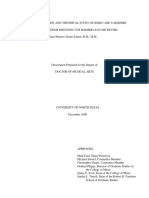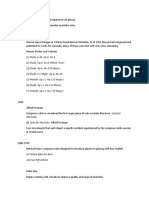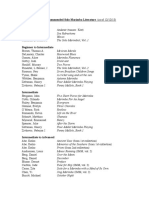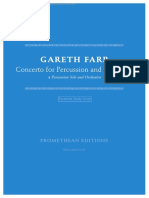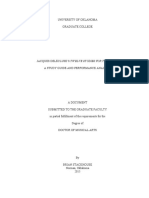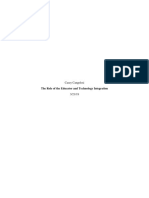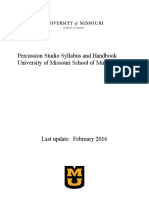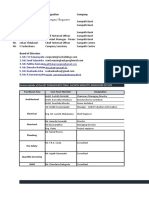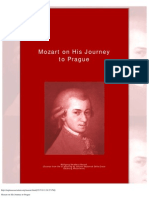Zeltsman
Zeltsman
Uploaded by
gizzy9dillespieCopyright:
Available Formats
Zeltsman
Zeltsman
Uploaded by
gizzy9dillespieOriginal Description:
Original Title
Copyright
Available Formats
Share this document
Did you find this document useful?
Is this content inappropriate?
Copyright:
Available Formats
Zeltsman
Zeltsman
Uploaded by
gizzy9dillespieCopyright:
Available Formats
Nancy Zeltsman
The Power of Nuance
By Rick Mattingly
I
t was a standard
question, one that
Nancy Zeltsman
frequently asks of new
students as a first step
towards assessing their
backgrounds and
beginning to plan their
subsequent musical
journeys. But the answer
she received from a photo: claudiahansen.com
freshman who had
arrived from Arizona to
specialize on marimba
at Bostons Berklee College of Music was far from what
Zeltsman expected when she asked the student to name
her favorite marimba players.
PERCUSSIVE NOTES 4 MAY 2013
To view videos and audio associated with this article, access the
digital edition of this issue at www.pas.org/publications/
Video/Audio
percussivenotes/notesonline_copy1.aspx
I dont know any marimba players, the student replied. she has never been to a concert, and never heard a profes-
Dont you have any marimba CDs? Nancy asked. sional performer. It was not from lack of interest; she just
No. didnt have the chance to see and hear things before com-
Have you ever been to a concert by a marimbist? ing to Berklee, and didnt know what to seek out. She had
No. only heard people play who were as experienced as she
What kind of concerts have you been to? was.
Ive never been to a concert. I started lending her CDs, Nancy recalls. Every week I
Have you ever seen anyone play the marimba? let her borrow a different marimba CD to check out so she
Well sure, the student replied. On YouTube. could hear a variety of players and learn about repertoire
Okay, Zeltsman said, slightly relieved. Who did you and different playing styles. At first, she liked only the most
see? easy-listening pieces, but that gradually started to expand.
I dunno. Just some other kids who were playing pieces I At one point I suggested she go hear the Boston Sym-
was working on. phony. She came in a week later and said, You are going
That exchange, in Nancys own words, blew my mind. to be so proud of me! I got tickets to hear the Berklee Or-
But it opened her eyes in regard to where some of the chestra! And I said, Well, thats nice, but its not the same
current generation of students world is located. Its on as hearing the Boston Symphony, and she said, Why not?
YouTube, Zeltsman says. We all know that there is bril- Then she came to hear a recital by one of my top marimba
liance on YouTube as well as a bunch of noise. But Im not students at The Boston Conservatory, Rachel (Xi) Zhang.
sure that some students know how to get to the brilliant Rachel played a lot of contemporary music that was chal-
stuff. Heres a girl who has just arrived to major in music, lenging listening but utterly captivating. Afterwards, this
photo by
Liz Linder
PERCUSSIVE NOTES 5 MAY 2013
marimba. But there are very few technical exercises in the
books nearly 200 pages.
Nancys Recommended Mallet CDs Some approaches to teaching are based on, Okay, lets
get your technique together and then well play some mu-
These recordings offer soulful playing in a variety of sic. That always seemed strange to me, I guess because of
musical styles and go in some very creative directions. how I was raised, Nancy says. My approach to teaching is
They would add up to a great introduction to the in- based on, first, being thoughtful about repertoire choices,
strument for people who havent heard many mallet and then, as soon as you start a piece, trying to figure out
CDs (and might provide some new suggestions for what your real goals are for it. I believe that technical is-
those who have). Some of these include chamber play- sues are best considered in service of musical goals. Of
ing with great instrumentalists (too numerous to list course, its tricky to start pushing toward lofty goals for a
here). There are certainly many great marimbists and piece that you might be crawling through, sight-reading.
albums not represented here; this is just a start. Nevertheless, I try to get students to dream about where
they want to take a piece from the beginning so that, ide-
Artist Title ally, all their playing feels like music-making.
Another dilemma is how to get students thinking of
Pedro Carneiro Ukiyo grander ideas about music and expression when they dont
Orlando Cotto Caribeos think that they know enough to think that way yet. Ill ask,
David Friedman Air Sculpture What kind of spirit does this piece have? Does it have
Jean Geoffroy J.S. Bach: [Violin] Sonates BWV a light mood, a complicated mood? I try to get them
1001, 1003, 1005 thinking about the colors of the notes, the feeling it evokes.
(or Geoffroy playing any Bach) Thats why we play music, because it evokes complex feel-
Tatiana Koleva No Sugar Added ings. Some music is just kind of happy or sad, but the stuff
Joe Locke Beauty Burning we really respond to is much more complicated. Its what
Fumito Nunoya Red Dragonfly we cant put into words.
Sinske Thats Marimba! When Im working with students who dont know how
Julie Spencer Ask to dig for something deeper, Ill tell them, You actually do
Mutsumi Tsuuzaki M X Piazzolla respond to something in this piece, so build on it and trust
that you can say something more meaningful. Then, every-
thing else falls into place. If they get a character in mind,
that affects the sound quality, and therefore the touch they
Berklee student looked dazed. She got it! Thats when it are going to use, and therefore what kind of stroke they are
clicked for her that all performers are not at the same level. going to use and the dynamic balances. At that point, all of
I have to tell you that she has become one of my favor- their decisions about how to play the piece are in the ser-
ite students, Zeltsman says, with obvious delight. She vice of a grander goal, and that goal is coming into better
is a sponge, and shes a blast, and I cant believe how far focus.
shes come. It feels like shes absorbed everything Ive ever Although Zeltsman will sometimes steer a student to-
said to her. At first, she was playing a lot of ostinato pieces, wards a particular interpretation of a pieceperhaps
which I made her promise to play only with a metronome because she has performed it herself and knows it well,
because she had time problems. Then I had her play a Boc- or she has had conversations with composers about their
cherini flute concerto with a pianist. I demonstrated for goals for particular worksshe is open to her students
her how, in this classical style, a melody has to sound very own ideas about how a piece can be played.
smooth and sort of balletic, and she would mimic me until Its really great when you question how students do
the phrases began to flow naturally, her own way. By the something, thinking that you are then going to tell them
end of her freshman year, she played a groove piece on a how it should be, and instead they say, Well, I was really
concert with absolutely steady pulse, without a metronome, thinking about it like this, and they proceed to spell out
and the Boccherini with elegant style. I was near tears at this whole scenario of how they think the piece should be
that concert. How did this girl get all of this? She needed played. Thats exciting for me, and I almost always cheer on
somebody to put it in front of her. But not many people their own idea.
you put that in front of could digest it all. That was one of Nancy cites a time when Fumito Nunoya was studying
the coolest things that has happened for me as a teacher. with her and had started to learn a piece that was required
That episode also illustrates Zeltsmans primary concern for a competition. He played it for me one week, and he
as an educator and a performer: focusing on music over played it well, but I wasnt impressed with the piece itself.
technique. It is reflected in her book, Four-Mallet Marimba So I wasnt excited when he asked to play it for me the fol-
Playing, in which she states in the introduction, It is im- lowing week, Zeltsman admits. But I soon found myself
possible to grow as a musician without playing a lot of completely transfixed. When he finished, I said, What hap-
music. Accordingly, the book contains 50 musical etudes, pened to this piece?! Fumito replied, Ah! I have a story!
18 solos appropriate for recitals, auditions, or juries, and He had devised an involved narrative that went along with
examples from the solo and chamber-music repertoire for this music. Once he had a storyline, everything made sense
PERCUSSIVE NOTES 6 MAY 2013
to himand to me! Of course, I didnt have any idea of experience reinforced that direction, which is fine. But I try
what his story was when I heard him playing, but it gave to get them to combine that with some color.
the music a flow in some mysterious way. We may never In striving for this higher musical goal, I sometimes
know what someones personal story behind a piece is, but find myself shaking my head like, No, thats not it. Even if
its almost a foolproof way to give a piece an organic trajec- students are playing really well, I can sense when theyre
tory. primarily engaged in what they are doing rather than what
Another way that Nancy has helped open up students they want to hear. The latter involves being totally engaged
to the expressive possibilities in music is by paying atten- and focused on the sounds youre making and having a
tion to their personalities. I might say, I saw you act really clear intention of an atmosphere you want to create. Often-
goofy the other day, and it was so funny! Now, in this piece times Ill say, Okay, you were only thinking about what you
of music, this next phrase is actually kind of goofy. So what were doing, right? And theyll say, Yeah, actually I was.
can you do to bring that out by your touch, your sound, You can practice in stages, Zeltsman suggests. For
and your phrasing? instance, there might be some lick thats a crazy configura-
Learning to tap into a creative spirit often comes with tion, and you have to just think about what your hands are
being exposed to a lot of influential music, as with the doing. So you focus on the awareness that you are now
Berklee student; or making up a story to go with a piece, working on a technical thing. Then you gradually change
like Fumito did; or by making connections to the music on the balance until you are able to just hear what you are do-
a personal level. I can use any or all of those three paths to ing without thinking about your hands.
help people figure out how to make these connections for
themselves and go for something deeper than just target
practiceplaying the right notes.
So many people are excited about playing the marimba
these days, Zeltsman says with a mix of amazement and
Z eltsman first came to prominence in the mid-1980s
with the marimba/violin duo Marimolin with violinist
Sharan Leventhal. The team was very active for 11 years,
satisfaction. At Berklee, youve been able to declare vibra- until 1996, and released three CDs. Nancy also recorded
phone your principal instrument for years. More recently, three solo CDs (Woodcuts, See Ya Thursday, and Sweet Song);
you have also been able to declare marimba your princi- recorded William Thomas McKinleys marimba concerto
pal instrument. We actually have about equal numbers of with the Boston Modern Orchestra Project; released a duo
marimba principals as vibraphone principals now. A lot of marimba CD with Jack Van Geem titled Pedro and Olga
people just love playing the marimba, generally in a classi- Learn to Dance; and presented recitals and marimba master
cal context with written music. But I think its strange that classes across the U.S. and Europe, as well as in Japan and
what draws many people to the instrumentthe earthy Mexico.
sound, the magic of a slab of wood resonatingoften gets Since 1993, she has taught marimba in positions that
forgotten once they get mallets in their hand and start real- were created for her at Berklee College of Music and The
izing how hard it is to hit these targets. Their focus turns Boston Conservatory, where she has been Chair of the Per-
to just getting the notes. The sound that initially seduced cussion Department since 2005. She has been Artistic Di-
them ends up way down their list of concerns. Of course, rector of Zeltsman Marimba Festival (ZMF) since 2001an
maybe some people love to play marimba because its a annual two-week seminar held in a different location each
blast to wield mallets. Maybe their frontline drum corps summer. She is the author of the method book Four-Mallet
Encore Mallets enable me to bring out the full,
deep tones I love most about the marimba.
Nancy Zeltsman
Photo: www.claudiahansen.com
437 Southfork Dr., Suite 100,
Lewisville, TX 75057
www.encoremallets.com
PERCUSSIVE NOTES 7 MAY 2013
ementary school, find the best pianist, and convert her into
We play music because it a percussionist. That had worked out well, so Goldie did it
again two years later with Nancy, and although Zeltsman
didnt immediately focus on marimba, she was on the path
evokes complex feelings. Its that would lead to her eventual career.
Nancy began studying privately with Robert Ayersa
what we cant put into words. Juilliard graduate who eventually founded Ayers Percus-
sion, a rental firm in New York. He was an amazing private
teacher, Nancy says. I would walk away from every lesson
with my eyes bugging; he turned me on to something so
Marimba Playing (Hal Leonard) and editor of Intermediate cool every time.
Masterworks for Marimba (C.F. Peters)24 marimba solos When Nancy was in tenth grade, due to her extensive
presented in two volumes, commissioned through ZMF piano background, Ayers suggested that she needed to
with support from over 200 contributors. Nancy holds a de- work with a mallet-percussion specialist. He recommended
gree in percussion performance from New England Con- xylophone virtuoso Ian Finkel.
servatory, where she studied with Vic Firth. I kept studying timpani and percussion weekly with
Her involvement with music began at age five when her Bob, Nancy explains, but my dad would drive me to New
parents signed her up for ballet and piano lessons. After a York City, which was a little over an hours drive from
year, her mother asked her, If you can only continue with where I grew up in New Jersey, and I would have a two-
one of these, which would you choose? hour lesson every other week with Ian.
I chose piano, Nancy says, and I have joked since then Zeltsman vividly recalls Finkels studio. Three of the four
that that was the moment when I became physically unfit walls had floor-to-ceiling shelves crammed with alphabeti-
for the rest of my life. But I think I already felt a connec- cally filed music. Facing one of those walls was a xylo-
tion with music. phone; facing another was a marimba; facing the third was
Nancy continued piano lessons, describing herself as a a vibraphone.
pretty serious classical pianist. During her last several of Ian had me study each of them as an individual dis-
years in elementary school, she became accompanist for cipline, Nancy says. A typical assignment would be an
the school chorus and school shows. Although she knew entire violin concerto on xylophone, six pages of David
that she was a musician at heart, she wasnt convinced Friedmans book Damping and Pedaling on vibraphone, and
that piano was her instrument. Then, near the end of her six pages of chordal guitar music for four mallets on ma-
elementary school days, the band director from the junior rimba. I would have to come back in two weeks and play all
high she would be attending sought her out. of thatand he never let me repeat an assignment once in
Her name was Goldie Marrs, and she said, Ive been two years. It was a ridiculous amount of music to learn, but
wanting to meet you because your grandfather is my fa- I got better and better at sight-reading and pretty fearless
thers best friend, and Ive heard about you. Im going to about learning anything.
be your band director next year. You could take up percus- Nancys high school had a xylophone and vibraphone
sion very easily because you know the grand staff, so you that she could practice on, so her parents bought her a
can read treble-clef xylophone parts and bass-clef timpani marimba. Ian got me interested in taking each one very
parts. She went on to tell Nancy that her husband, Donald
Marrswho would eventually be Nancys high-school band
director and who she describes as one of the most impor-
tant teachers of my lifetaught a summer band program
nearby in Parsippany, New Jersey. Goldie suggested that
Nancy could try playing percussion over the summer, and
if she liked it, she could join Goldies junior high band in
the fall. That intrigued Nancy, and she signed up.
By the end of the first day at the band camp, I had
played timpani and was absolutely hooked, Zeltsman says.
Thats it; Im a percussionist.
Countless stories exist about band directors dumping
the least talented kids into the drum section, so why did
Goldie Marrs encourage an accomplished pianist to pursue
percussion? It turned out that there was more to Marrs
interest in Nancy than the connection to Zeltsmans grand-
Photo: claudiahansen.com
father. Goldie and Donald Marrs had a son named Stuart,
who was majoring in percussion at Indiana University (and
is now percussion director at the University of Maine in
Orono). Nancy suspects it might have been Stuarts urging
a couple of years earlier that led his mom to visit the el-
PERCUSSIVE NOTES 8 MAY 2013
seriously, but I certainly wasnt going to specialize on xy- ticulations, different stroke weights, dynamic nuances, and
lophone, because that was his thing, and for many years I so on.
really didnt like the vibraphone. Between Ian instilling the Nancy cites the Marimolin recording of Threedance, in
idea of specialization, and the reality of the instrument I which composer Robert Aldridge sought to join marimba
had in my house, things pointed toward the marimba. and tabla to create a super-percussion instrument.
Zeltsman notes that Finkel never had her work on tech- Across dizzying meter changes, all the players have con-
nical exercises; all the time she spent with him was devoted stantly changing dynamics, Nancy explains. Various kinds
to playing actual music. I occasionally run across students of marimba attacks and strokesranging from sharp and
who are anxious for me to turn them on to the magic ex- strident, to less loud but full and clear, to soft and cushi-
ercises that are going to make everything fall into place, onywork hand-in-hand with the dynamics to simultane-
Nancy says. Sometimes Ill ask a student, What are your ously provide changing characters and colors. One place
goals for this semester? and the reply will be, I want to the marimba finally ties in with the violin, as opposed to
work on my technique. My answer is, How about if we the tabla, is at 8:20 where we play a series of low-to-high
work on a piece of music, and you can build technique as unison lines. There, I love the opportunity to match the
we go? different characteristics of the violin across registers. Like-
Personally, I hate technical exercises and dont have wise, Sharan matched the last note of each phrase so that
time for them, she says. Its hard enough to find time her violin note has the same envelope as a marimba note
to play and learn music, so why would I want to spend a in terms of the attack, length, and how it fades.
chunk of every day playing boring patterns? I advocate Another piece on which the marimba and violin articula-
recognizing technical exercises that exist within the dif- tions are well matched is Marimolins recording of Steven
ficult passages of the pieces you are working on. The Mackeys Feels So Baaad, on which Zeltsman and Leven-
tricky things that come up here and there in pieces are far thal are joined by Mackey on guitar along with two percus-
more challenging than a lot of exercise patterns, not only sionists. The piece showcases the violin and marimba as
because of the sticking or some technical challenge, but a team, mostly in traditional melody and accompaniment
because a piece introduces context. Maybe theres a tricky roles, Nancy says. At 3:50, we team up to play the back-
sticking; Im pretty obsessed with stickings and how they ground rhythm part, blending our sounds and matching
relate to phrasing. Maybe the passage also needs to be dynamic contours. As it crescendos, the initial attacks are
played pianissimo, which gives it a musical context that ul- also carefully matched. The coda also gives us a chance to
timately makes it more difficult than if you were just trying blend instrumental timbres. Along with her marimba per-
to punch the notes out. formance on the track, Nancy boasts that she contributed
Finkel taught her to play with four mallets using tra- the sound of snow shovel on brick at the 1:25 spot on the
ditional cross grip, which was employed by most players recording!
at that time. I never even saw anyone hold four mallets As Zeltsman looked for ways to incorporate a variety
before I met Ian, Nancy recalls. And then I still didnt see of articulations on marimba, she became convinced that
any four-mallet playing for awhile, aside from David Fried- her grip was serving her well. With traditional grip, you
man and Dave Samuels, who I kind of followed in their mainly hold the mallets in the back fingers, she explains,
New York days. so you can greatly vary the pressure you use with the
As other grips became popular and widely used, did she front fingers. You can hold the sticks really tight or super
ever experiment with them? loose, which you cant really do with any other grip. So I
Never, she replies. The main reason is just that I feel feel that my hands are pretty free, like theyre modeling
if it aint broke, dont fix it. Having met a lot of players clay in terms of how Im stroking and making different
who use different grips, and who are phenomenal with colors. The years with Marimolin challenged me most and
Stevens grip and Burton grip and different variations on really solidified what Im interested in. I like nuance; Im
both of those, Ive never seen anything that made me feel not interested in playing super technical and fast. To me,
that there was something I wanted to get at that I couldnt its more interesting to play something that has a simple,
do with my grip. As I had the opportunity to observe the unusual spin on the sound than playing something more
virtues of other grips and what they were best suited for, spectacular or dazzling. Its a quiet thing that I hope draws
they didnt fit with my playing style. people in.
A lot of students tell me that the thing they notice most Zeltsman never pressures students to switch from using
about my playing is my sound. My approach developed a a grip they are already comfortable with. Maybe with one
lot during the years I was playing with Marimolin. Com- out of a hundred students I might suggest that they give
posers would designate that Sharan play with a variety of traditional grip a try, if whatever grip they are using doesnt
articulations and coloristic devices on violin and I would seem to be working for them, she says. For instance,
think, Okay, she has all these different ways to put a spin people with really small hands sometimes have trouble
on what shes playing; I want to do that too! In mixed with Stevens grip because they are holding the mallets at
chamber music, you encounter instruments on which the very end, and therefore dont have very good lever-
sound is produced differently than your own. Its fun to age. Other times I will show students who use a different
cross-fertilize how you each make sound. A couple of de- technique a cool articulation or coloristic thing, and they
cades later, I would say Im even more obsessed with ar- are intrigued to try it with traditional grip. But thats not
PERCUSSIVE NOTES 9 MAY 2013
always the case. Canadian marimbist Anne-Julie Caron, there is a lot of music that adapts beautifully to marimba
a Stevens-grip player with phenomenal facility and tech- by classical composers other than Bach, Nancy explains.
nique, figured out a way to do every coloristic thing I sug- Back when Zeltsman studied with Finkel, very little
gested to her when she studied with me some years back, instructional material or repertoire existed for keyboard
so thats great! percussion instruments, compared to the amount of mate-
Ultimately, you should go with whatever grip makes rial that is available today. Is there a virtue in adapting and
the mallets feel comfortable in your hands. Sometimes Ill learning pieces originally written for other instruments,
show students traditional grip, and after a couple of weeks as opposed to strictly learning music that is idiomatic to a
theyll say, Im not feeling this. Fine, then youre done mallet-keyboard instrument?
with it. Its not going to work for everybody. People cite Yes! says Nancy. Amid pieces composed for guitar,
Joe Locke as that rare vibist who uses Stevens grip, but it harp, piano, cello, flute, etc., you will find some really great
isnt really Stevens grip. Joe spent a short time with Leigh music that works beautifully on marimba. Most marimba
Stevens many years ago when Joe was looking for the best music was composed in the last several decades, so its
way to hold sticks. Joe didnt have enough time with Leigh great to look at older music. Studying music from different
to get it textbook right, but he developed it into what can periods, and in different styles, is a great resource to draw
only be called the Joe Locke grip. I dont know if anyone upon in expanding your range of musical expression.
else uses it, but it certainly works for him. I think its great Music adapted from pieces written for other instru-
when people invent their own modifications to grips to ments might not be inherently idiomatic, but it can still be
custom fit themselves. very successful. The same is true of a lot of music that is
My work with Ian showed me that traditional grip was written for marimba. Some of it is idiomatic and some of
amply adaptable to any challenges that might arise; I might it isnt. A lot of times, the idiomatic music is composed by
try something different with one finger or turn my wrist a marimba players. Some non-marimbist/composers have re-
different way. There was far more focus on how to adapt ally thought through the mechanics of playing and the id-
music. For example, he taught me which notes to drop iosyncrasies of the instrument in order to make everything
from a chord that had too many notes to play with four lay well for performers. But a lot of composers havent.
mallets, or how to creatively break the chord so the chord Instead they write what they imagine will sound beautiful
color would be preserved. coming from the voice of the marimba, even if it isnt idi-
One of the guitar pieces that Finkel introduced Nancy to omatic.
was Sonata, Op. 77 by Mario Castelnuovo-Tedesco, which For example, Threedance posed an interesting techni-
she recorded some 30 years later. The second movement cal challenge of extremely fast shifts between wide inter-
of that piece is a good example of the sound world I really vals, including alternating ninths and seconds. I developed
like to live in, explorations with rubato, and the fact that a method of quickly closing the intervals, relying partly
on gravity to let the mallets fall closed, and then quickly
catching them for the second.
I dont mind at all when composers write in a non-
idiomatic way; they are giving us a vehicle to help stretch
what the instrument can say. Many times, the technical
challenges are well worth it.
R eflecting on a career spanning nearly 30 years, Nancy
says that her interest was always in learning a lot of
new pieces. She has premiered over 125 solo and chamber
music worksmost of them commissioned by herin-
cluding compositions by Paul Simon, Michael Tilson
Thomas, Gunther Schuller, Carla Bley, and Louis Andries-
sen.
In recent years, as I have less time to devote to learning
new music, Im feeling that, yeah, there are pieces I have
a special connection with because Ive lived with them for
a few decades, Zeltsman says. So I dont feel as driven to
play as many new pieces as I used to.
In terms of pieces I feel Im really identified with, Mer-
lin by Andrew Thomas is one of my favorites and, I feel,
Photo: claudiahansen.com
a landmark piece. Its challenging and I sometimes shy
away from it, but I really enjoyed playing it several times
in the last year, as 2012 marked the 25th anniversary of the
first time I played it. See Ya Thursday by Steven Mackey
is another signature piece thats dedicated to me. Gunther
Schullers Marimbology and Paul Lanskys Three Moves
PERCUSSIVE NOTES 10 MAY 2013
for Marimba were both dedicated to me, and premiered A lot of the pieces Ive been drawn to are sort of groove
by me. I recorded Over There by Carla Bley, Amulet by pieces and jazz influenced pieces, she explains. Even
Paul Simon and Mindwalk by Lyle Mays as part of the though I didnt pursue being an improviser, I was funda-
Intermediate Masterworks for Marimba double-CD. Jack mentally very affected by jazz. My love of playing pieces
Van Geem and I were the featured marimbists for the pre- with a deep groovenot so much ostinato pieces or mini-
miereand many subsequent performances, including one mal pieces, but pieces with cool, funky bass lineshas
at PASIC 2003of Michael Tilson Thomas Island Music, been reflected in my repertoire for years. In addition, Ive
his 35-minute masterpiece for two featured marimbas, two always valued works in a contemporary language, ones with
tutti marimbas, and two percussionists. interesting forms, harmonies and rhythms, atmospheric ef-
Recently, Nancy has been developing a program to be fects, and colors.
called sotto voce. That term means under voice or under A lot of the music Im currently playing is simpler in
the breath, and it will reflect the kind of pieces that really some waysmaybe what some would call easy listening
interest me the most now: softer pieces that are full of nu- compared to some of the major contemporary works for
ance, she explains. marimba. I used to feel that a program should show the
One motivation for the program is that, four years ago, entire range of musical languages I relate to but, for now, I
Nancy suffered a problem with her hearing. I now have a feel that I dont need to tell you all that. I just want to play
slight hearing loss in one ear, and I became very sensitive from what feels like my center.
to loud volumes, she says. I wear musicians earplugs a lot One of the pieces that will be included in sotto voce is the
when I teach. first movement of Daniel Levitans Marimba Suite #2.
But a bigger reason behind the new program is that, at She has already made a video of the piece, but it does not
this point in her life, she wants to concentrate on the mu- show Nancy playing. Instead, the music is heard behind
sic she loves the most. Ive always been conscious about photos taken by Nancys mother, Martha, who was a nature
repertoire choices being representative of your knowledge photographer. Those photos will be projected when Nancy
about music, your taste, your personality, your values. Late- performs the piece live.
ly, though, Ive been experimenting with going in a new di- This is a great example of the quiet, nuanced playing
rection. Im not worrying so much about the implication of Im interested in now, Zeltsman says. This piece came out
every repertoire choice I make; Im just figuring out what I of a period about a year ago when I took a year off from
really like to play. Some people might think its all too soft doing ZMF. I was kind of burned out on all fronts and
and slow, but its what I feel like playing right now. needed to juggle a bit less for awhile. There was a stretch
Photo: Michael Ptacin
After a performance of Michael Tilson Thomas Island Music at ZMF 2011, with close friends / ZMF peeps: L to R: Dane Richeson,
Rachel (Xi) Zhang, Jack Van Geem, Mike Truesdell, Brian Calhoon
PERCUSSIVE NOTES 11 MAY 2013
of time when this piece was the only one that drew me shared with each other was a feeling that we were falling
inwhere I could forget myself. So Im really attached to behind the times by not having released performance vid-
it. In a broad sense, the piece is about beauty in simplic- eos of ourselves. So we decided to start with that. We will
itywhich is the same theme that ran through my moth- follow our debut on these videos with our concert debut in
ers photographic work, as a whole. A lot of her photos are Boston in January of 2014.
much more dramatic than the ones in this video, but for The other piece Zeltsman and Norsworthy created
this particular piece I chose images depicting things that a video for is Shawn Michaleks Tinaja/2006/banana-
are peaceful and genuine, like walking in the forest and gram. Is there a story behind the title? Those are the
seeing a little bird or a curlicue fernappreciating beauty three movement titles; the composer refused to give it an
in simplicity. overarching title, Zeltsman says, laughing. Shawn was a
At one point in the video, Nancy reads a poem over the masters marimba student of mine at Boston Conservatory,
music: Plainness by Jorge Luis Borges. In a broad sense, and after that, he was a masters composition major there.
simplicity is what this poem is about, too, Nancy says, He attended the first festival I put together, which was in
quoting a section of the poem: This is the best that can Princeton in 2001 and, when ZMF became an annual event
happennot to be wondered at or required to succeed, in 2003, he was my main assistant every summer until 2010.
but simply to be let in, as part of an undeniable Reality. We shared equally in running the Intermediate Masterworks
Its about being able to feel truly comfortable with peo- project, so weve logged a lot of hours and special times
ple, Nancy says, softly. Isnt it nice when you are in a set- together. I was grateful Shawn wrote this piece for me with
ting where you dont have to work at anything? Youre just clarinet. It has never been performed live. Michael and I
accepted. Thats another version of beauty in simplicity. made a studio project out of this, so this video is the world
Music that fits the sotto voce concept and that also ap- premiere! Its a quirky piece with unusual challenges, but
pears on a video is Nancys adaptation for marimba and I think people will find it fun. The end of the video has a
clarinet of three movements from Olivier Messaiens Po- short clip of Shawn talking about the piece.
emes pour mi, a set of songs for soprano and either piano Yet another piece that fits into the sotto voce concept is
or orchestra. I first heard it performed at Tanglewood in Zeltsmans own composition, Black Velvet, which was in-
1975, just before I was a senior in high school, on what spired by Nancys black Labrador Retriever, Mochi. When
was probably the first concert of contemporary music I he was a puppy, he slept like a velveteen bundle in our
ever heard, Nancy recalls. Messaien himself played piano! laps, but grew to a mighty 85-pounder who could take off
Later I realized what a historic event that was,
and I still recalled the evening well. I always re-
membered those pieces for soprano and piano.
I chose three movements that I felt would work
very well for clarinet and marimba.
The third piece seen in the Messiaen video,
movement VI, Ta Voix, shows one of the things
I usually caution composers against writing. I
typically tell them, Pretty much anything you
can play with any four fingers on the piano will
work on marimba; just go easy on parallel thirds,
as the interval shifts are tough on the wrists. But
I loved this Messiaen piece so much that I chose
to do the thirds anyway! All three are really
beautiful pieces and a little bit understated. Im
very happy with the way the video performances
turned out.
The video clips alternate from showing the
musicians in the studio to showing them in a
concert setting. That music and those videos
were edited by Steve Rodby, longtime bassist and
producer for the Pat Metheny Group.
The clarinetist is Michael Norsworthy, a col-
league of Zeltsmans on the faculty of Boston
Conservatory. I really love the combination of
Photo: Warren LaFever
clarinet and marimba, Nancy says. We decided
to do two video projectsthe Messaien pieces
and a work by Shawn Michalekas our first
projects together. Usually, when you document
a duo, its because you have already worked
together. One of the things Michael and I first Performing at PASIC 2009
PERCUSSIVE NOTES 12 MAY 2013
on a leash with me flying behind him like a kite, she says. toire choices are so critical, Zeltsman says. With my stu-
Mochi was extremely opinionated about music; he par- dents, I am looking for their repertoire choices to reflect
ticularly liked Debussy and jazz balladsor so it seemed their interests, personalities, and their niche as a player.
because thats when he would stay in the room, get com- Im doing that myself, too. I feel like Im going in a little
fortable, and let out a deep sigh of satisfaction. With other bit of a radical direction. Nancy trails off, looking for
music, hed get up and leave, somewhat disgruntled. the right explanation, but then realizes that the answer is
I wanted to compose a piece he would like to nap to. simple: Because I can!
And so I wrote every note, over many sessions, while he
was curled up contentedly. I was trying to get to what I SELECTED NANCY ZELTSMAN DISCOGRAPHY
imagined might be an ideal musical language for dogs. Solo Marimba
Sometimes, while he was fast asleep on his side, all four, Woodcuts, 1993
big paws would move, like he was dreaming of happily run- See Ya Thursday, 1999
ning. The music at 3:41 is my imagined perfect soundtrack Sweet Song, 2005
for a dream about heroically chasing down a Frisbee in a
giant field. With Marimolin (Sharan Leventhal, violin; Nancy Zelts-
Mochi can actually be heard on the recording. I re- man, marimba; plus guests)
corded him sleeping on a bed, with a delicious, light spring Marimolin, 1989 (nominated for a Grammy; received 10/10
breeze floating over him. At the 3:00 mark, theres a lovely rating in CD Review Magazine)
little snorta momentary startle! I perform the piece as Marimolin: Combo Platter, 1995
a solo sometimes but, for me, this version is far better. Its
interesting to get sucked into his very slow breathing as a Marimba Duos with Jack Van Geem
separate pulse overlaid over the rubato pulse of the piece. Pedro and Olga Learn to Dance, 2004
The marimba part exemplifies my love of deep, fun-
damental-rich sounds and wide-interval voicings, Nancy With Boston Modern Orchestra Project (Gil Rose, con-
adds. ductor)
Im entering a new way of looking at repertoire, which William Thomas McKinley: Marimba Concerto, 2010 PN
has been somewhat of a struggle, because I think reper-
Are you getting the full
Percussive Notes experience?
Nancy Zeltsman: The Power of Nuance
Video
Daniel Levitans Marimba Suite #2, 1st movement
Three movements from Olivier Messaiens Poemes pour mi
Shawn Michalek: Tinaja/2006/bananagram
Audio
Robert Aldridge: Threedance
Steven Mackey: Feels So Baaad
Mario Castelnuovo-Tedesco: Sonata, Op. 77, II. Andantino, quasi canzone
Nancy Zeltsman: Black Velvet
Mexican 4-Octave Marimba Music
Video: MidAmerica Nazarene University marimba ensemble performing Las Chiapanecas
Integrating the Front Ensemble with Battery Exercises
Audio Examples
Check out our digital edition: www.pas.org/publications/percussivenotes/notesonline_copy1.aspx
PERCUSSIVE NOTES 13 MAY 2013
You might also like
- Three Moves For Marimba - Paul LanskyDocument10 pagesThree Moves For Marimba - Paul LanskyD. C100% (4)
- 2300 Degrees SCORE PDFDocument15 pages2300 Degrees SCORE PDFJesusJesseTapiaNo ratings yet
- Chromatic FoxTrot - RagtimeDocument13 pagesChromatic FoxTrot - RagtimeBenja Urrutia Santander83% (6)
- The Evolution of Solo Marimba ReportoireDocument41 pagesThe Evolution of Solo Marimba ReportoireCyrus ChanNo ratings yet
- M. Peters - Fundamental Solos For TimpaniDocument36 pagesM. Peters - Fundamental Solos For TimpaniAnita Primorac100% (3)
- Catching Shadows: Drum SetDocument3 pagesCatching Shadows: Drum SetRyan Greenberg100% (2)
- Abel - 20th Century Orchestra Studies For Percussion - The Boston ConservatoryDocument2 pagesAbel - 20th Century Orchestra Studies For Percussion - The Boston ConservatoryYork R0% (1)
- BarcelonaDocument6 pagesBarcelonaHari Kuttivelil100% (3)
- Percussion Duo RepertoireDocument3 pagesPercussion Duo RepertoireGiuseppe Maiorana50% (2)
- Wind TranspositionDocument2 pagesWind TranspositionMatthew Maxwell100% (4)
- Four Mallet Daily Warm UpDocument5 pagesFour Mallet Daily Warm UpGeorge KazianisNo ratings yet
- Time For MarimbaDocument8 pagesTime For MarimbaJulio Acosta100% (1)
- Keiko AbeDocument65 pagesKeiko AbeAnonymous ptRZOyNo ratings yet
- Ney Rosauro's "Concerto For Marimba and Orchestra": by Domenico E. ZarroDocument3 pagesNey Rosauro's "Concerto For Marimba and Orchestra": by Domenico E. ZarroFrancesco BrunoNo ratings yet
- Bill Cahn CatalogDocument5 pagesBill Cahn Catalogduerdenj2591No ratings yet
- Pocket Change: Ndugu Chancler Is a World Renowned Drummer,Percussionist,Producer,Composer, Clinician and EducatorFrom EverandPocket Change: Ndugu Chancler Is a World Renowned Drummer,Percussionist,Producer,Composer, Clinician and EducatorNo ratings yet
- Brass MethodsDocument7 pagesBrass Methodsgizzy9dillespieNo ratings yet
- Arranging For Athletic Bands: Music 675Document16 pagesArranging For Athletic Bands: Music 675gizzy9dillespieNo ratings yet
- Development of Malaysian ArtDocument15 pagesDevelopment of Malaysian Artapi-556581864No ratings yet
- Solo 4.3-Oct Marimba Literature (4-Mallets Only) : Compiled by Dr. Brad Meyer (Stephen F. Austin State University)Document7 pagesSolo 4.3-Oct Marimba Literature (4-Mallets Only) : Compiled by Dr. Brad Meyer (Stephen F. Austin State University)TiraRod o0o0oNo ratings yet
- GradingFourMalletMarimbaLiterature PDFDocument48 pagesGradingFourMalletMarimbaLiterature PDFChance CaprarolaNo ratings yet
- Percussion-Getting A College Teaching PositionDocument2 pagesPercussion-Getting A College Teaching PositionsandranoriegaNo ratings yet
- Marimba PaperDocument41 pagesMarimba PaperMJSway100% (2)
- 100 Years of Marimba Solo Repertoire DevelopmentDocument3 pages100 Years of Marimba Solo Repertoire DevelopmentFrank Acosta100% (1)
- Nomad Tom Gauger PDFDocument4 pagesNomad Tom Gauger PDFMattiaNo ratings yet
- Kevin Bobo - 4 Mallet ExercisesDocument7 pagesKevin Bobo - 4 Mallet ExercisesSeth DyerNo ratings yet
- Refining Your Timpani RollDocument5 pagesRefining Your Timpani RollthegastonexperienceNo ratings yet
- TriangleDocument80 pagesTrianglealexandre biondiNo ratings yet
- Repertoire ListDocument12 pagesRepertoire ListCarlesNo ratings yet
- Cook - Percussion Handbook ProjectDocument10 pagesCook - Percussion Handbook Projectapi-620356806100% (1)
- Jacques Delecluse PDFDocument4 pagesJacques Delecluse PDFAnsambl Ri100% (3)
- Marimba Repertoire List 2003Document2 pagesMarimba Repertoire List 2003Tobías Alvarez100% (1)
- List of Works 2021Document6 pagesList of Works 2021Paolo Marcello Battiante100% (1)
- Must Have - For Percussion LibraryDocument9 pagesMust Have - For Percussion Libraryvianny esquivel100% (1)
- Marimba Four HandsDocument5 pagesMarimba Four HandsChance CaprarolaNo ratings yet
- 4-Mallet Exercises - 2017 PDFDocument26 pages4-Mallet Exercises - 2017 PDFjohap7No ratings yet
- Brian Ekstrom, Percussion: Senior RecitalDocument8 pagesBrian Ekstrom, Percussion: Senior Recitalbrian ekstromNo ratings yet
- Gymnopédie - MarimbaDocument2 pagesGymnopédie - MarimbaNicola CampanellaNo ratings yet
- Percussion CurriculumDocument20 pagesPercussion CurriculumBryan J. Hummel75% (4)
- Accessory Percussion Clinic HandoutDocument9 pagesAccessory Percussion Clinic Handoutalexandre biondiNo ratings yet
- Marimba Grips Analysis DLDocument16 pagesMarimba Grips Analysis DLalbertNo ratings yet
- Ivan Trevino - Heat StrokeDocument6 pagesIvan Trevino - Heat StrokeValerio Vicinanza100% (2)
- 100 Years of Marimba Solo Repertoire DevelopmentDocument3 pages100 Years of Marimba Solo Repertoire DevelopmentFrank AcostaNo ratings yet
- Associate Principal Percussion and Timpani Excerpts 2017Document124 pagesAssociate Principal Percussion and Timpani Excerpts 2017chaohua fu100% (2)
- Cameleon - Yellow After The Rain - GitanoDocument22 pagesCameleon - Yellow After The Rain - Gitanoaaronbilsky100% (3)
- Marimba Grips AnalysisDocument16 pagesMarimba Grips Analysislewopxd100% (3)
- Alberi MarimbaDocument3 pagesAlberi Marimbajonaseneand100% (1)
- Spirals NotesDocument1 pageSpirals NotesIp Cheng XinNo ratings yet
- Front Ensemble Technique ManualDocument5 pagesFront Ensemble Technique ManualSir FlamalotNo ratings yet
- Zeltsman, Nancy - Marimba LiteratureDocument3 pagesZeltsman, Nancy - Marimba Literatureulianovmarín100% (1)
- Footpath For Solo MarimbaDocument15 pagesFootpath For Solo MarimbaMarluce RodriguesNo ratings yet
- PARTITURA The Warning Lights Are Blinking Red SCORE Double SidedDocument11 pagesPARTITURA The Warning Lights Are Blinking Red SCORE Double SidedJorge Mario Mendoza Gutierrez100% (1)
- Gareth Farr Percussion Concerrto - Fullscore PDFDocument86 pagesGareth Farr Percussion Concerrto - Fullscore PDFMarta SoggettiNo ratings yet
- Multi Perc RepDocument3 pagesMulti Perc RepgiannisNo ratings yet
- 4511896-Rain Dance by Alice Gomez and Marilyn RifeDocument6 pages4511896-Rain Dance by Alice Gomez and Marilyn Rifejohn greene100% (1)
- Jacques Delécluse's Twelve Studies For The Drum: A Study Guide and Performance AnalysisDocument169 pagesJacques Delécluse's Twelve Studies For The Drum: A Study Guide and Performance Analysisvictor_sanchez143777050% (2)
- Cangelosi AssignmentoneDocument5 pagesCangelosi Assignmentoneapi-459381865No ratings yet
- Texas HoedownpdfDocument9 pagesTexas HoedownpdfLorenzoBertacchiniNo ratings yet
- Bach for Solo Marimba: 25 Violin Sonatas and PartitasFrom EverandBach for Solo Marimba: 25 Violin Sonatas and PartitasRating: 1 out of 5 stars1/5 (2)
- Percussion Instruments - Purchasing, Maintenance, Troubleshooting & MoreFrom EverandPercussion Instruments - Purchasing, Maintenance, Troubleshooting & MoreNo ratings yet
- Special Challenges of Arranging For Marching Band: by Ed GastonDocument1 pageSpecial Challenges of Arranging For Marching Band: by Ed Gastongizzy9dillespieNo ratings yet
- To: Prospective Santa Clara Vanguard Percussionists Re: 2018 Auditions/First CampDocument2 pagesTo: Prospective Santa Clara Vanguard Percussionists Re: 2018 Auditions/First Campgizzy9dillespieNo ratings yet
- RepertoireDocument13 pagesRepertoiregizzy9dillespie100% (1)
- Unison Warm UpsDocument25 pagesUnison Warm Upsgizzy9dillespieNo ratings yet
- 4564-2017 Front EnsembleDocument1 page4564-2017 Front Ensemblegizzy9dillespieNo ratings yet
- 4 Mallet Fundamentals by Garwood WhaleyNeil GroverDocument5 pages4 Mallet Fundamentals by Garwood WhaleyNeil Grovergizzy9dillespie0% (1)
- MUSC37 137A-D Lemmon Galen F15Document9 pagesMUSC37 137A-D Lemmon Galen F15gizzy9dillespieNo ratings yet
- OcpDocument17 pagesOcpgizzy9dillespieNo ratings yet
- Teaching PercussionDocument12 pagesTeaching Percussiongizzy9dillespieNo ratings yet
- Mu Percussion HandbookDocument23 pagesMu Percussion Handbookgizzy9dillespie100% (1)
- Front Ensemble Technique PacketDocument15 pagesFront Ensemble Technique Packetgizzy9dillespieNo ratings yet
- Studio Semester ReqDocument27 pagesStudio Semester Reqgizzy9dillespieNo ratings yet
- Keyboard Percussion Curriculum - Eastman Community Music School - Eastman School of MusicDocument6 pagesKeyboard Percussion Curriculum - Eastman Community Music School - Eastman School of Musicgizzy9dillespie100% (1)
- ENVision 4 Mallet Accents - MalletsDocument2 pagesENVision 4 Mallet Accents - Malletsgizzy9dillespieNo ratings yet
- Isu Applied StratagemDocument10 pagesIsu Applied Stratagemgizzy9dillespieNo ratings yet
- Clay Vocabulary WorksheetDocument4 pagesClay Vocabulary Worksheetapi-373754262No ratings yet
- 811 The Orange TreeDocument31 pages811 The Orange TreeEvelina Tomonyte50% (2)
- Bill of Quantities Sample Template.Document1 pageBill of Quantities Sample Template.Jhon Walter Ortega CondeNo ratings yet
- The Role of Memory Image Place and StorDocument18 pagesThe Role of Memory Image Place and StorAmanda MocoNo ratings yet
- November Rain - Sandi - (Guitar Score)Document1 pageNovember Rain - Sandi - (Guitar Score)Jabes SaitananNo ratings yet
- 222economics Rank ListDocument16 pages222economics Rank ListarpurushwappNo ratings yet
- Cinema - Newson 39 S Language CentreDocument2 pagesCinema - Newson 39 S Language Centreacademiaedel25% (4)
- Miteam Color Chart Final 2020Document1 pageMiteam Color Chart Final 2020noorazaan3No ratings yet
- Kk-Hsb-In-002 - CNC Partition Wall Detail1Document1 pageKk-Hsb-In-002 - CNC Partition Wall Detail1Ragul KumarNo ratings yet
- Conceptualartorganicline PDFDocument19 pagesConceptualartorganicline PDFisabelmarcosNo ratings yet
- High Art: Ken Johnson On How 1960s Drug Culture Transformed Fine ArtDocument2 pagesHigh Art: Ken Johnson On How 1960s Drug Culture Transformed Fine ArtLucas MagalhãesNo ratings yet
- Boq of Praposed Public Library at Pune: NO Item Qty. Unit Rate AmountDocument20 pagesBoq of Praposed Public Library at Pune: NO Item Qty. Unit Rate AmountSaurabh KotechaNo ratings yet
- Platillo VoladorDocument5 pagesPlatillo Voladorfabiana fernandez diazNo ratings yet
- The Delphi CharioteerDocument2 pagesThe Delphi CharioteerGayatri GogoiNo ratings yet
- Winter Wonderland 17 Winter Patterns To Crochet PDFDocument65 pagesWinter Wonderland 17 Winter Patterns To Crochet PDFinformatica.paula6988100% (2)
- Sex Drugs Etc Lyrics - Penelusuran GoogleDocument1 pageSex Drugs Etc Lyrics - Penelusuran GoogleVii NcansNo ratings yet
- Contact List - Sampath CentreSSSSSSSDocument8 pagesContact List - Sampath CentreSSSSSSSJagath Aruna ShanthaNo ratings yet
- Art Education in NigeriaDocument54 pagesArt Education in NigeriaAdelekan FortuneNo ratings yet
- გურამ დოლიძე.ალბომი.ნაწილი 1Document75 pagesგურამ დოლიძე.ალბომი.ნაწილი 1Khatuna Dolidze0% (1)
- Karate GlossaryDocument7 pagesKarate GlossaryMagdalena TabaniagNo ratings yet
- Objectives of This Case Study:: Resort and RecreationalareaDocument10 pagesObjectives of This Case Study:: Resort and RecreationalareaJyotiNo ratings yet
- A Brief History of PostersDocument5 pagesA Brief History of PostersChrstn CrsraNo ratings yet
- Barbie High-Low Cocktail Dress (Free Crochet Pattern) - FeltMagnetDocument1 pageBarbie High-Low Cocktail Dress (Free Crochet Pattern) - FeltMagnetAriiadniita SanchezNo ratings yet
- Mozart On His Journey To PragueDocument48 pagesMozart On His Journey To Praguewolfen6mannNo ratings yet
- Garment Defects and Root CauseDocument47 pagesGarment Defects and Root CauseMd Majharul IslamNo ratings yet
- CMEA Final 2018 Conference Program-2Document88 pagesCMEA Final 2018 Conference Program-2Jordan Hugh SamNo ratings yet
- Nicholas Mina Art 489 Resume Draft 3Document2 pagesNicholas Mina Art 489 Resume Draft 3api-286010169No ratings yet
- Lesson 2: Basic Assumptions, Functions, Philosophies and Nature of ArtDocument6 pagesLesson 2: Basic Assumptions, Functions, Philosophies and Nature of ArtMa. Rochelle CabralesNo ratings yet
- ImagineFX - January 2018Document116 pagesImagineFX - January 2018Vedran100% (10)












